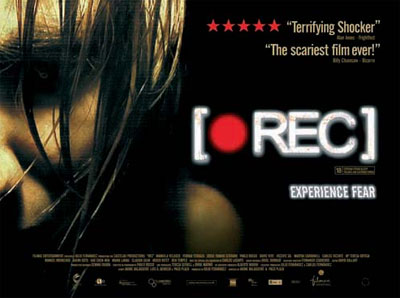I am not a fan of the horror genre. In fact, I avoid it. The last film that afflicted unbearable insomnia was Paranormal Activity (Peli, 2007). I did not understand what caused the eye luggage two years ago (Peli's film was such a trend back then). Perhaps it was the paranoia of the small details.
Over the one-day break, I felt discomfort (pressure? stress?) which later motivated me to watch pseudo-documentary horror films. [Rec] (Balaguero & Plaza, 2007) is a gorgeous Spanish film that incorporates horror cliches into an organism that breathes on its own. The Blair Witch Project (Myrick & Sanchez, 1999) set a new standard for horror during its period by allowing the audience to fear a witch that is never caught on film.
What contributed to the fear effect of the two films as well as Paranormal Activity was the point-of-view. All of which were 'filmed' with handheld cameras. This allows the audience to view particular vantage points. Also, as the 'cameraman' records selected scenes for the audience, he or she acts as a participant or character in the scenes. In [Rec], Pablo is never revealed but his heavy breathing and shaking voice adds to the mood of the film as well as exemplifies his role as a participant.
Horror films are actually implicit representations of a power struggle. Who exactly controls who? If the screaming TV host were to actually scare off these zombie-like creatures, then you have a gory comedy. However, that is not the case. These zombie-like creatures whose origins are vague and unknown run after the humans, bite them, and turn them into fellow zombies. The lack of knowledge on the origins of these zombies further worsens the power disparity between humans and zombies.
Films only go insofar as the camera and microphone wills to record. Select lines are uttered. Embellishments such as background music allow some moments to be emphasized. Each character, being representations of beings in real life, has his or her own context which the film tries to snip out and fit in a narrative.
Horror films are films. Some directors/producers aim for the audiences to be shit-in-their-pants scared but one has to take into account that horror films could be dissected into its elements and could be understood qua being a film.
[REC]
Rec later unfolds a context which roots to the Vatican and the mission of a priest to cleanse the world of an odd disease. Apparently, the disease makes the victims into zombie-like beings. A local TV reporter and her cameraman are lured into this context.
The primary plot mover of the film (because without this terrible irrationality, all the characters would have been saved) is the isolation. The characters are locked in an apartment building by government authorities because of the possibility of a Bio-hazard. Because of that, there is no room to scream for help. Danger swims towards its victim and the victim is helpless. Horror plots feed on that premise and so [Rec] dances along.
The secondary plot mover is Angela, the woman who insists that the whole event be filmed. Most horror films have this character archetype: the daredevil or curious cat which insists that its companions to join him or her into the suspicious.
One may imagine that the whole film becomes a playing field. The setting is isolated and there is no escape. The characters are already helpless as it is. Angela as the lead pushes the narrative of While You Sleep which is pregnant with the contexts of the TV reporter, the cameraman and the firemen converges with the narrative of the Vatican and the zombie disease. The film plays with cliche elements like disease, zombies and intense isolation and it worked.
The Blair Witch Project
The Blair Witch Project is remarkable in a film age wherein horror is attached to the scarier-looking flesh-eating supernatural being. The main antagonist in this film is the witch who is never seen. The plot mover is the idea of being lost while filming a documentary about the Blair Witch who I hope is a representation of the history of Blair.
The key element of the film is the unknown. What are those sounds? What in the world do those piles of rocks mean? Compared to Rec, whose horror we later understand is a disease, the Blair Witch leaves the horror completely to the viewer's imagination. No one is explicitly being dismembered. No real children are seen. We don't even hear the witch's cackle. Nothing makes any sense. It is a play on the human condition that has improved over the years because of scientific and logical knowledge.
Because the film focuses on the human condition, its main characters are emotional and scared human beings who react to their surroundings. They hear and see things that the few years of their lives have never imagined. The only context they know is that of the people they interviewed and the legends that they have heard.
Anyway, that's enough discussion. I was merely typing my thoughts on the two films. Perhaps in the future my world view will mature and the perspectives I pick in viewing films will be more tasty. Yes, tasty. If you are frightened, listen to something sexy.
If you liked my musings (hihi, feelingera?) on these two films or disliked them so much and are masochistic, try reading my other filmy posts: Eraserhead (Lynch, 1977) and Eternal Sunshine of the Spotless Mind (Gondry, 2004)

